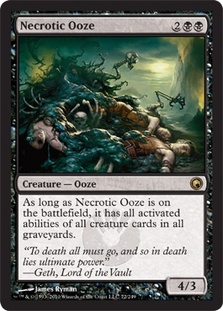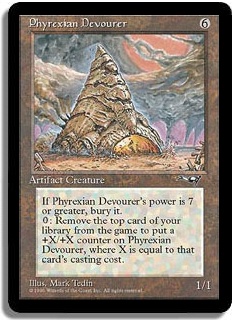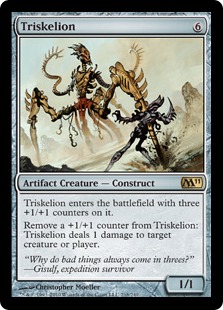Every “best deck” in Legacy has been hunted to extinction at one point or another. Metagame shifts and card adaptations may take shorter or longer depending on the dominant deck or strategy, but things eventually return to equilibrium. Absent a new flagship card, no one deck can destroy the format.
Griselbrand decks have proven to be no exception to this rule. Grand Prix Atlanta showcased the sheer diversity of ways to answer the eponymous 7/7 Legendary Demon: theft, bounce, forced sacrifice, honest removal, countermagic, and a whole host of graveyard based hate. It’s a tough world out there for those of us who would rather not play fair.
The thing is that most people adapt when confronted with adversity. It’s not a mystery why you can’t sleeve up this:
Creatures (8)
Lands (18)
Spells (34)

…and win a tournament with it. People want to beat you.
Beyond just being good sense to pack graveyard hate, there is something extra viscerally satisfying about beating an unfair linear deck with an especially hateful card.
Those of you who have Shatterstormed or Fracturing Gusted Affinity know what I’m talking about. Those of you who have seen your Dredge opponent’s shoulders slump when you have Leyline of the Void in games 2 AND 3, you know what I’m talking about.
And the one person in history who has ever Aura Thiefed an Enchantress player?
You definitely know what I’m talking about.
So people heard about this really good Reanimator deck and decided they want to beat it. So they did. And now, it’s time to adapt.
This article started as a homework assignment of sorts. I was chatting with Gerry Thompson about the state of Legacy, and he expressed his frustration at not having a good way of killing an opponent on the same turn that he puts Griselbrand into play. In his book, “good” means “works well with the rest of the deck.”
Suggesting the addition of four Nourishing Shoal and four Autochthon Wurm, for instance, is not particularly good since your Plan B is really more of a follow-up Plan A—if your Plan A doesn’t come together, your Wurm/Shoal plan is not going to win you any games.
So what are we really looking for?
What kills people the turn you cast it and costs the fewest number of deck slots?
As it turns out, not a lot. The fine folks at The Source have been trying to fit Tendrils of Agony into a Griselbrand shell for a while now, but that has its fair share of problems. The primary issue is that your storm kill doesn’t actually stand alone. If they have Leyline of the Void or Relic of Progenitus, you don’t actually have a Plan B—you are exceptionally bad at the normal sort of “counting to ten” that Storm decks can do.
 As it turns out, Tendrils-killing people is still extraordinarily hard when you dedicate your entire deck to it. Dedicating only half of your deck to it sounds like an excellent way to make Thalia, Guardian of Thraben an even bigger liability. And if they have Gaddock Teeg? Forget about it.
It was around this time that inspiration struck me from another era.
Creatures (26)
- 4 Birds of Paradise
- 1 Triskelion
- 1 Quirion Ranger
- 1 Basking Rootwalla
- 1 Phyrexian Devourer
- 4 Tarmogoyf
- 3 Noble Hierarch
- 3 Bloodghast
- 3 Vengevine
- 4 Fauna Shaman
- 1 Necrotic Ooze
Lands (19)
Spells (15)
Sideboard

Ken Adams, the consummate man-with-two-plans, built a post-Survival of the Fittest deck that incorporated the Necrotic Ooze / Phyrexian Devourer / Triskelion combo. For those of you not in the know, here are the cards:
…and here’s how it works.
Step 1: Buried Alive for Necrotic Ooze, Phyrexian Devourer, and Triskelion.
Step 2: Get Necrotic Ooze into play.
Step 3: Activate Necrotic Ooze’s Phyrexian Devourer ability and look at the exiled card’s converted mana cost. If the card costs zero, repeat this line. If the card costs one or two, go to step 4. If the card costs three or more, go to step 5. If the opponent responds with removal, repeat step 3.
Step 4: Allow the ability to resolve, putting one or two +1/+1 counters on Necrotic Ooze. Activate Necrotic Ooze’s Triskelion ability to shoot your opponent for one or two damage. Go back to step 3.
Step 5: Because exiling the card is a cost, you get to see how many counters would go on Necrotic Ooze before the Devourer ability resolves. Leave the ability activation on the stack and respond with another activation. In other words, go to step 3.
As long as all of your deck’s remaining one- and two-mana cards’ combined converted mana cost is greater than your opponent’s life total, this is a legitimate plan. What does a deck like this look like, then?
Creatures (7)
Lands (13)
Spells (40)
- 4 Brainstorm
- 4 Force of Will
- 2 Reanimate
- 4 Animate Dead
- 4 Dark Ritual
- 2 Exhume
- 4 Entomb
- 4 Buried Alive
- 4 Lotus Petal
- 4 Ponder
- 4 Preordain
Sideboard

This is the first thing I came to. The Buried Alive plan intersects with the Griselbrand plan, the Dark Rituals and Lotus Petals help cast Buried Alive in a reasonable time frame while also allowing you to Griselbrand into an actual kill, and the extra cantrips are better than discard because I would rather draw a Dark Ritual or Lotus Petal than Thoughtseize a Daze or Spell Pierce. In short, we can more easily beat taxing counters by building our deck proactively than by building our deck reactively.
I’ll point you to Gerry’s recent article on Modern Reanimator for a more succinct and eloquent explanation of why discard spells suck and being proactive is great. At the end of the day, it comes down to situations like this:
You have some number of fast mana (Petals and Rituals), and they have some number of taxing counters (Pierces and Daze). You both have Forces. You have 56 cards locked in. Here is the competition for your final four-of. Which would you rather play?
- (B), Sorcery: “Look at their hand. If they have a Spell Pierce, Force of Will, or Daze, counter it. If they just cast Brainstorm, this does nothing. If they don’t have a counter, this does nothing. Even if you take a relevant card, they can still draw another one of their twelve relevant cards or cantrip into them on their turn.”
- (U), Sorcery: “Dig for a situationally-appropriate card. If you miss, you’re still drawing live. If you hit, you can now beat more opposing hands whether or not they have a hate card.”
See how much better the second card is? It goes deeper than just game 1s, though.
Every cantrip you play makes your sideboard games that much better for you. Why? Because sideboards are supposed to have super effective cards. Why? Because you build them to do that. So if you play more cantrips, you’ll see more cards in each game. Seeing more cards means seeing more sideboard cards, which means your sideboarded games are going to have a higher rate of you playing a sideboard card and should correlate fairly directly with you winning. If that isn’t the case, blame your sideboard, not your cantrips.
Back to why anti-hate cards (including discard spells but also a broader category of cards) are mostly bad.
Locking yourself into playing an anti-hate card is so rarely correct that I would rather just not do it. Most hate cards are beatable. The super-powerful hate cards have forced out previous iterations of this deck, so we need to sidestep those cards instead of attacking them head-on.
For the same reason, playing a bunch of Pithing Needles and Not of This Worlds and Submerges in a traditional Reanimator shell is a losing battle. If you can sidestep one fight, though, you can certainly get a jump-start on winning another.
The sideboard, then, must not be a bunch of Dread of Nights or Null Rods or Perishes or backup Reanimation targets. It has to be a completely different plan—you can’t afford to fight Scavenging Ooze and Thalia, only to lose to Faerie Macabre. We can’t build our deck to beat Karakas and still lose to Crop Rotation for Bojuka Bog. That’s unacceptable.
Omniscience sidesteps all of that.
Show and Tell sidesteps the graveyard hate, and Omniscience sidesteps Karakas. Again, Petals and Rituals allow us to activate Griselbrand and win on the same turn—in this case, with a follow-up Show and Tell into Omniscience into “hard cast” Emrakul, the Aeons Torn.
Again, intersecting functionality here: you can Show and Tell twelve cards, your mana base allows you to Show and Tell faster, and your Force of Wills get better after sideboarding because you have more blue cards to pitch. This means that you can cast your cantrips without stranding your Force of Will more often. Also, you know, Preordain is way better than Thoughtseize or Daze, seeing as how we’re building our deck to care about the other side of the table as little as possible.
Those twelve transformational slots aside, why the Jaces?
Jace, the Mind Sculptor is there to help your control and combo matchups. Forcing an opponent to beat an accelerated Mind Sculptor in addition to a combo finish is preferable to playing a round of “do I have the right anti-hate card in my deck for this game state?”
If you don’t want to play Jace, I can understand that. Since you’re playing Emrakul and Griselbrand, though, you might want to consider Not of This World in its place. Vendilion Clique is another possibility that also fights combo and control, but it interacts poorly with Dark Ritual. Maybe you just want to play a few Personal Tutors to maximize your Show and Tells. You could also add a few mana sources instead of the Jaces. At the end of the day, this is still a thirteen-land deck. Play and build accordingly.Â
While we’re on the topic of lands, I’d just like to point out that the fetch configuration is super cutesy and can basically be any nine fetchlands that get Underground Sea. My thought was to mimic RUG’s mana base because people are more likely to hold back against “Misty Rainforest, go” than any other fetchland. The Bloodstained Mire is there to look like Goblins on a slow start. Again, it’s mostly irrelevant, but getting in the habit of paying attention to details like this is worthwhile. The more places you look, the more places you can find hidden pockets of value.
My second idea, awkwardly enough, was worse than my first idea. The general plan was to rip off Gerry Thompson Modern Reanimator idea. If you ever wanted to lose an entire game to Spell Snare, this is the deck for you:
Creatures (8)
Lands (16)
Spells (36)
- 4 Brainstorm
- 4 Goryo's Vengeance
- 4 Force of Will
- 4 Dark Ritual
- 4 Entomb
- 4 Careful Study
- 4 Shallow Grave
- 4 Lotus Petal
- 4 Ponder
Sideboard

This build started as a way to get a better Griselbrand activation. A common problem for traditional Reanimator has been that Reanimate doesn’t get hit by Spell Snare and is less vulnerable to Daze and Spell Pierce, but it also “costs” you seven cards if you happen to be Reanimating a Griselbrand. Not as good.
Goryo’s Vengeance and Shallow Grave don’t cost you any life and play well with both Dark Ritual and Emrakul, the Aeons Torn. When you compare them to Reanimate in terms of fueling a same-turn kill, you basically get fourteen more cards.
The problem, of course, is that you need at least six slots for a same-turn kill: three Buried Alive and your three-part combo. What are you cutting? Buried Alive and your Reanimation effects don’t play particularly well together. You could cut Careful Study, which plays far better with your Reanimation effects, but now your Emrakuls are much worse. You could cut your Emrakuls, but now you’re just the first deck with fewer ways of getting a Necrotic Ooze into play.
All of those obstacles kind of ruled out the same-turn kill.
But now what do we have? An upgraded Modern deck? We lose to Spell Snare and Karakas, we’re all in on our instant half the time because of Emrakul’s disappearing act, and when we do resolve our instant, half the time it’s just a fifteen-point three-card Lava Axe. Sure, we can annihilator them, but that means letting them develop their mana base to the point where they could have countermagic or access to Karakas.
Not a great set of options. So what to do from here?
As is often the case in Legacy, people don’t play the most powerful cards available to them. If someone wants to mix it up in Kansas City, I’d be interested in helping them out and seeing how it performs.
For those of you who don’t want anything to do with Griselbrand and read this in search of the daily seared ahi special, here are some things to keep in mind about Legacy moving forward:
- People will keep playing tribal decks on the SCG Open Series, no matter how bad they are.
- Merfolk decks still don’t have a way to beat Ensnaring Bridge. They should all be playing Dismember (and maybe Gut Shot) nowadays, so Peacekeeper isn’t the lock you want it to be.
- On a similar note, it seems pretty hard to believe that a Land Tax deck wants zero Moxes of any kind whatsoever.
- Land Tax is the new Standstill. If you want to know how to play against it, beat this game first (hat tip to Patrick Chapin for that).
- I don’t think you can have too many Relic of Progenitus in your U/W Control list this weekend. It cycles, it beats a range of degenerate decks that rely on a high game 1 win percentage, and it drags out games against RUG Delver to where you can Counterbalance lock them.
- Goblins is a real deck if people aren’t going to kill you on turn 2.
- The winning RUG list played three Force of Will. The last time a stock RUG list played fewer than four Force of Will, Show and Tell decks crushed the next two weeks of SCG Legacy Opens. Likewise, Grim Lavamancer is very weak against turn 2 kills.
- You should have a compelling reason to play Stoneforge Mystic over Counterbalance in your Tundra deck. The Terminus builds can beat tribal decks. Enchantments are better against RUG than artifacts. Land Tax is excellent in the mirror. What other excuses do you have?
- The correct way to build Maverick involves at least two planeswalkers, likely more. The way to beat tribal is to grind them out and force each card to interact on its own merits. When you give a tribal player time to create synergies, you’ll start losing very quickly. Garruk and Gideon are both good at forcing interactions.
- RUG and Maverick both play real answers to artifacts. No one is playing Krosan Grip. What enchantments should you be playing right now?
Just some food for thought.
Sorry for the break. The political cycle pauses for no one. I would rather not write an article than write thoughtlessly and poorly. I hope you understand. My intention is to get back on a weekly pattern. I appreciate your patience.
@drewlevin on Twitter



